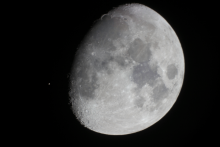Listen to today's episode of StarDate on the web the same day it airs in high-quality streaming audio without any extra ads or announcements. Choose a $8 one-month pass, or listen every day for a year for just $30.
You are here
Moon and Aldebaran
Every star sits at the middle of its own “bubble” — a region of space dominated by the star’s magnetic field and its “wind” of hot gas. For the Sun, the bubble spans billions of miles — at least 150 times the distance between the Sun and Earth. For other stars, though, it can be much larger.
An example is the bubble surrounding Aldebaran, the bright star that represents the “eye” of Taurus, the bull. The star lurks quite close to the Moon tonight, so it’s hard to miss.
Aldebaran itself is a giant. It’s at the end of its life, so it’s puffed up like a hot balloon. As it gets puffier, more hot gas escapes from its surface and races out into space. Right now, in fact, Aldebaran is losing enough material to make a planet as massive as Earth in about a quarter of a million years.
As the gas expands, it gets cooler — cool enough for atoms to begin linking together to make molecules. Astronomers have detected molecules of water, carbon monoxide, and other compounds around the star.
Even as the dust forms, though, the wind keeps on blowing. It doesn’t stop until the gas and dust get thin and slow enough that they’re blocked by the material in interstellar space. For Aldebaran, that happens at about a thousand times the distance from Earth to the Sun.
At that boundary, the wind piles up, so it gets hotter and denser. That outlines the edge of Aldebaran’s bubble — and the end of the giant star’s realm.
Script by Damond Benningfield




